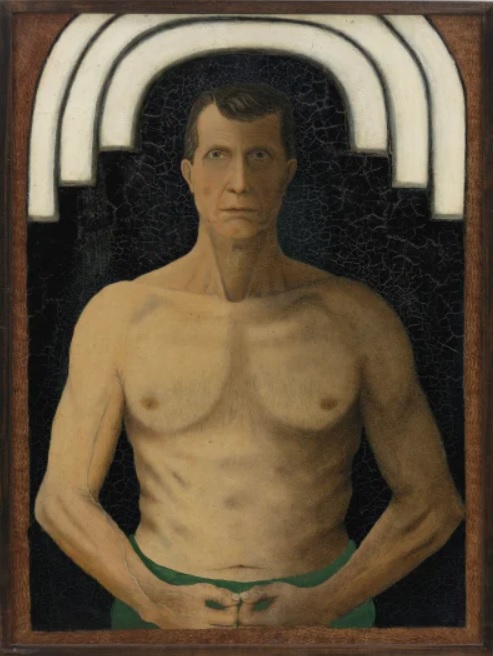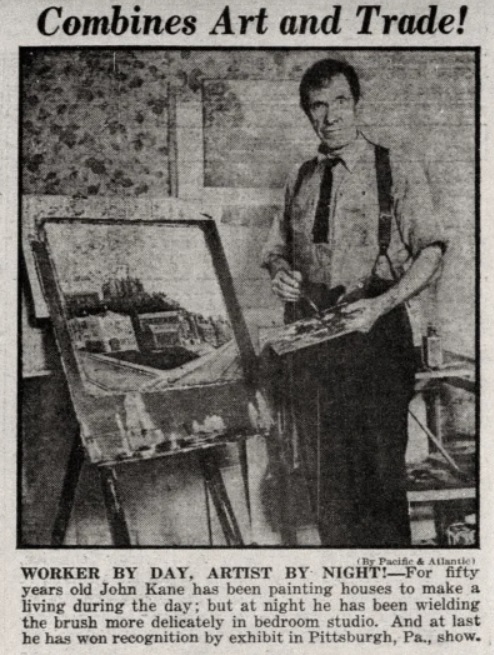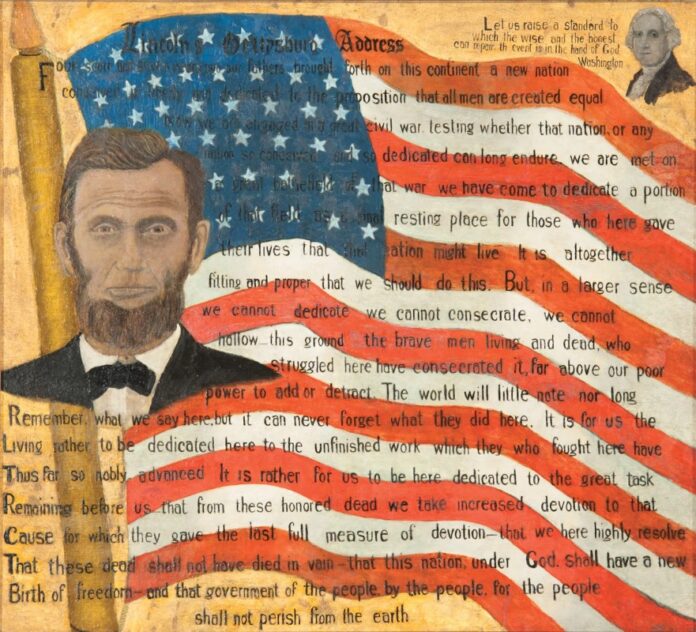The painter John Kane is unfamiliar to many. However, it wasn’t at all times that means.
In 1927, the New York Every day Information ran an article about Kane beneath the headline “Combines Artwork and Commerce!” {A photograph} that got here with the article confirmed the plainspoken artist at his easel, portray a quaint scene exhibiting Pittsburgh, the Pennsylvania metropolis he referred to as dwelling.
Three years later, when he turned the one hometown artist to make the participant checklist of the Carnegie Worldwide, Pittsburgh’s internationally revered biennial that also takes place right this moment, the New York Times devoted a whole merchandise to Kane. In being included in that present, he had by some measures grow to be the primary self-taught artist within the U.S. to indicate at a museum. The newspaper reported that Kane was thought of to be “the ‘discover’ of the technology” by “worldwide juries,” and quoted the artist as saying, “My neighbors inform me the critics are troubled whether or not I be impressionist, modernist or classicist, however this stuff I don’t perceive.”
How, precisely, did an artist so blissfully conscious of the modernist avant-garde draw a lot acclaim that Edward Hopper even referred to as himself one among his defenders? And the way does an artist with such a following drop out of artwork historical past? American Workman: The Life and Artwork of John Kane (Princeton College Press), a brand new biography by Maxwell King and Louise Lippincott, explores these questions, which have some difficult solutions.
For Lippincott, a former curator on the Carnegie Museum of Artwork, these solutions lie within the false methods many people have chosen to categorise artists who don’t take a standard observe to fame.
“Immediately, [scholars and dealers] file Kane in a multicultural ‘outsider’ field with people, self-taught, Sunday, naïve, and vernacular artists, as MoMA considers dropping them from the canon altogether,” Lippincott writes. “However even on this modern context, designed to showcase reasonably than marginalize the undervalued achievements of ladies, Black, rural, and indigenous artists, Kane the surly getting older white male laborer stays completely out of fashion.”
Lippincott’s assertion in regards to the Museum of Trendy Artwork isn’t fairly true—the gallery nonetheless hangs Kane’s 1929 self-portrait within the museum’s “Masters of Well-liked Portray” gallery. A real gem of MoMA’s assortment, it contains a shirtless Kane flexing for the viewer, the veins in his arms bulging thus far out, they seem as if they could pop by way of his pores and skin. However she is correct that the problematic phrases “outsider” and “primitive,” each of them employed towards racist, sexist, ableist, and classist ends, have lengthy dogged Kane’s work. One of many first instances that MoMA confirmed that self-portrait, the portray figured in a present of “trendy primitives.”

John Kane titled this portray Seen within the Mirror for a 1928 exhibition, and John Kane within the Trying Glass in 1931. John Kane, Self-Portrait, ca. 1929. Museum of Trendy Artwork/Licensed by SCALA/Artwork Useful resource, NY
And so it’s with this e book that Lippincott and King, a former editor of the Philadelphia Inquirer, purpose to set the report straight. Lippincott asserts that “the disconnects between elite and employee languages and cultures” partially clarify the misunderstandings, a few of that are most likely willful ones. Sky Hooks, an “autobiography” of Kane was authored by journalist Marie McSwigan, consists of numerous misguided particulars, in keeping with the writers of American Workman. Fortunately, there’s this new biography to disentangle some these lies.
For biographers, Kane’s life story poses a singular situation: he didn’t commit himself to artwork till comparatively late in life, although at what level can be up for debate. (Lippincott writes that earlier than Kane confirmed in museums, he painted between 1899 and 1927 for his bosses and his fellow staff who, she writes, served for him as “his ‘modern artwork world.’”) To resolve that drawback, King and Lippincott divided American Workman into two sections that they wrote individually, one targeted virtually solely on Kane’s life, the opposite on his artwork.
King takes the biographical half of Kane’s profession, which King begins some years earlier than the artist was even born in 1860 in West Calder, Scotland. King briskly charts how Kane’s dad and mom struggled financially in Scotland, after which how Kane got here in 1880 to the U.S., the place he took jobs within the railroad business, within the coal mining enterprise, and in manufacturing of coke, which is used to make metal.
What follows isn’t just artwork historical past but additionally labor historical past. That King involves rely so closely on chronicles of the extremely exploitative circumstances staff confronted in Pittsburgh on the time to assist clarify how Kane got here to drawing isn’t a coincidence. For Kane, there was no separation between artwork and work.

John Kane by an easel, picture accompanying information article within the New York Every day Information, October 21, 1927. Newspapers.com.
As King writes, the drawings Kane made whereas he was a employee served as “a mirrored image of the world round him, a inventive outlet within the lifetime of a hardworking laborer, and an expression of his character, more and more given to solitude.”
Artwork might have additionally been a welcome reprieve from the difficulties his life offered, which included a leg harm that occurred when a practice ran over it (he didn’t accumulate damages from the railroad as a result of he was within the incorrect, he stated), a wrestle with ingesting that we’d now acknowledge as alcoholism, and cracks in his marriage that resulted from his dependancy. However it was not till the very finish of the nineteenth century that he took up a brush when he turned a home painter—the job that “contributed most of all in direction of my inventive work”—and it was not for a pair many years after that that he would commit himself extra absolutely towards artwork.
What Kane wound up producing is unclassifiable. There have been landscapes of Pittsburgh through which rollicking inexperienced fields exist aspect by aspect with business. There have been self-portraits just like the one in MoMA that acted as a showcase for Kane’s pecs (and, reasonably unusually, his prosthetic leg). There have been patriotic topics, reminiscent of one portray paying homage that features textual content from Lincoln’s Gettysburg Handle, and there have been private ones, reminiscent of pictures of Kane himself laboring away (on artwork, that’s).
Greater than anything, this can be a profoundly bizarre physique of labor, one thing that American Workman appears unwilling to acknowledge. Take Kane’s 1933 portray Pietà, which contains a weeping Virgin Mary earlier than two cathedrals that may nonetheless be noticed right this moment in Pittsburgh. Transposing an art-historical picture of the previous onto the Rust Belt of Kane’s current is a very unusual machine, however it’s one which makes this portray sing. You need Lippincott to loosen up a bit of when she picks aside Kane’s attainable allusions to Sixteenth-century portray and concludes that Pietà is a “private allegory” that encapsulates his personal religion.
Nonetheless, Lippincott must be applauded for the deep analysis in her half of the e book, which focuses solely on Kane’s artwork. There’s a bent to romanticize Kane’s artwork as being emblematic of the American expertise, and she or he for probably the most half doesn’t fall into that lure. If something, she has devoted herself to knocking those that achieve this down a peg.
The organizers of the Carnegie Worldwide, for instance, rejected Kane’s portray Hills and Rivers, Steamboat at Sleepy Hole, through which inexperienced ridges are proven from an elevated viewpoint. This panorama could appear quaint, however it accommodates secrets and techniques legible solely to those that know the way to learn them. Nestled in a single hill is a constructing that Lippincott identifies as a “county jail incarcerating Pittsburgh’s poor.”
“Kane’s view depicts the brief path between a Pittsburgh workman’s earthly success and failure, however its native, working-class symbolism could be misplaced on a jury of modernist painters from out of city,” she concludes.
Are members of the art-world elite nonetheless like that jury, interested in artwork like Kane’s however uncertain fairly what to do with it? American Workman means that instances could also be altering, and so too does a present like “Outliers and American Vanguard Artwork,” a landmark 2018 survey that aimed to reposition “outsider artwork” to be much less exclusionary. Kane figured in that present alongside figures extra broadly accepted within the worldwide artwork world, together with Betye Saar and Greer Lankton. Whereas Kane’s work should be a fixture at MoMA, possibly it’s time he’s damaged out of that stuffy “Masters of Well-liked Portray” gallery. American Workman might present the groundwork for doing simply that.

























